warning lights PORSCHE 911 CARRERA 2010 5.G Owners Manual
[x] Cancel search | Manufacturer: PORSCHE, Model Year: 2010, Model line: 911 CARRERA, Model: PORSCHE 911 CARRERA 2010 5.GPages: 310, PDF Size: 3.39 MB
Page 8 of 310
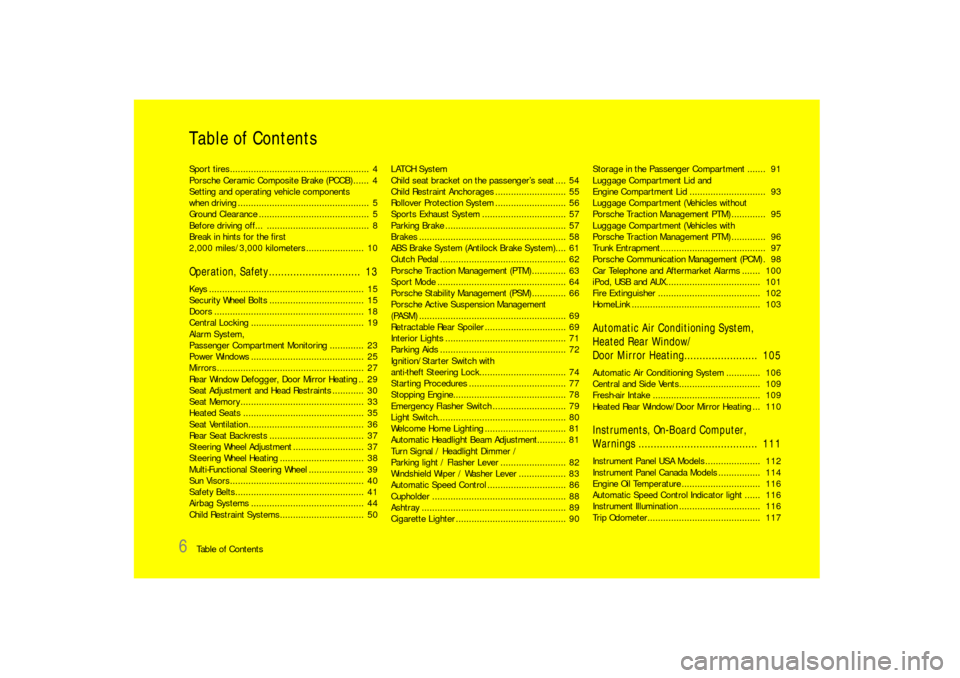
6
Table of ContentsTable of ContentsSport tires..................................................... 4
Porsche Ceramic Composite Brake (PCCB) ...... 4
Setting and operating vehicle components
when driving .................................................. 5
Ground Clearance .......................................... 5
Before driving off... ....................................... 8
Break in hints for the first
2,000 miles/3,000 kilometers ...................... 10Operation, Safety .............................. 13Keys ........................................................... 15
Security Wheel Bolts.................................... 15
Doors ......................................................... 18
Central Locking ........................................... 19
Alarm System,
Passenger Compartment Monitoring ............. 23
Power Windows ........................................... 25
Mirrors ........................................................ 27
Rear Window Defogger, Door Mirror Heating .. 29
Seat Adjustment and Head Restraints ............ 30
Seat Memory ............................................... 33
Heated Seats .............................................. 35
Seat Ventilation ............................................ 36
Rear Seat Backrests.................................... 37
Steering Wheel Adjustment ........................... 37
Steering Wheel Heating ................................ 38
Multi-Functional Steering Wheel ..................... 39
Sun Visors................................................... 40
Safety Belts................................................. 41
Airbag Systems ........................................... 44
Child Restraint Systems................................ 50LATCH System
Child seat bracket on the passenger’s seat .... 54
Child Restraint Anchorages ........................... 55
Rollover Protection System ........................... 56
Sports Exhaust System................................ 57
Parking Brake .............................................. 57
Brakes ........................................................ 58
ABS Brake System (Antilock Brake System).... 61
Clutch Pedal ................................................ 62
Porsche Traction Management (PTM) ............. 63
Sport Mode ................................................. 64
Porsche Stability Management (PSM) ............. 66
Porsche Active Suspension Management
(PASM) ........................................................ 69
Retractable Rear Spoiler ............................... 69
Interior Lights .............................................. 71
Parking Aids ................................................ 72
Ignition/Starter Switch with
anti-theft Steering Lock................................. 74
Starting Procedures ..................................... 77
Stopping Engine........................................... 78
Emergency Flasher Switch ............................ 79
Light Switch................................................. 80
Welcome Home Lighting............................... 81
Automatic Headlight Beam Adjustment........... 81
Turn Signal / Headlight Dimmer /
Parking light / Flasher Lever ......................... 82
Windshield Wiper / Washer Lever .................. 83
Automatic Speed Control .............................. 86
Cupholder ................................................... 88
Ashtray ....................................................... 89
Cigarette Lighter .......................................... 90Storage in the Passenger Compartment ....... 91
Luggage Compartment Lid and
Engine Compartment Lid ............................. 93
Luggage Compartment (Vehicles without
Porsche Traction Management PTM) ............. 95
Luggage Compartment (Vehicles with
Porsche Traction Management PTM) ............. 96
Trunk Entrapment ........................................ 97
Porsche Communication Management (PCM) . 98
Car Telephone and Aftermarket Alarms ....... 100
iPod, USB and AUX.................................... 101
Fire Extinguisher ....................................... 102
HomeLink ................................................. 103
Automatic Air Conditioning System,
Heated Rear Window/
Door Mirror Heating........................ 105Automatic Air Conditioning System ............. 106
Central and Side Vents............................... 109
Fresh-air Intake ......................................... 109
Heated Rear Window/Door Mirror Heating ... 110Instruments, On-Board Computer,
Warnings ....................................... 111Instrument Panel USA Models..................... 112
Instrument Panel Canada Models ................ 114
Engine Oil Temperature .............................. 116
Automatic Speed Control Indicator light ...... 116
Instrument Illumination............................... 116
Trip Odometer........................................... 117
Page 9 of 310
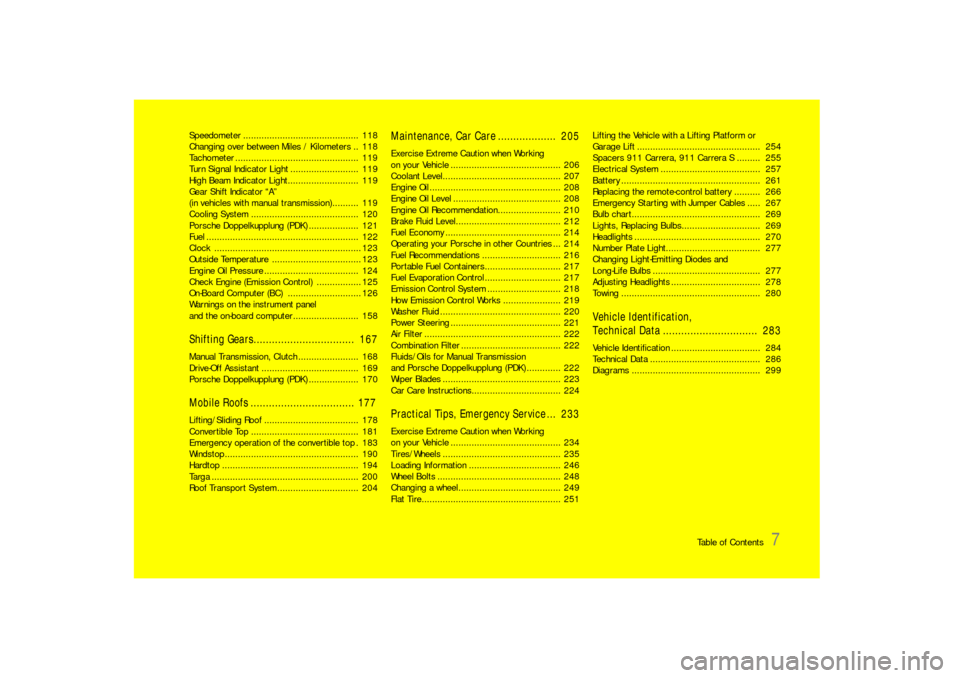
Table of Contents
7
Speedometer ............................................ 118
Changing over between Miles / Kilometers .. 118
Tachometer ............................................... 119
Turn Signal Indicator Light .......................... 119
High Beam Indicator Light........................... 119
Gear Shift Indicator “A”
(in vehicles with manual transmission).......... 119
Cooling System ......................................... 120
Porsche Doppelkupplung (PDK) ................... 121
Fuel .......................................................... 122
Clock ........................................................ 123
Outside Temperature .................................. 123
Engine Oil Pressure .................................... 124
Check Engine (Emission Control) ................. 125
On-Board Computer (BC) ............................ 126
Warnings on the instrument panel
and the on-board computer......................... 158Shifting Gears................................. 167Manual Transmission, Clutch ....................... 168
Drive-Off Assistant ..................................... 169
Porsche Doppelkupplung (PDK) ................... 170Mobile Roofs .................................. 177 Lifting/Sliding Roof .................................... 178
Convertible Top ......................................... 181
Emergency operation of the convertible top . 183
Windstop................................................... 190
Hardtop .................................................... 194
Targa ........................................................ 200
Roof Transport System............................... 204
Maintenance, Car Care ................... 205Exercise Extreme Caution when Working
on your Vehicle .......................................... 206
Coolant Level............................................. 207
Engine Oil .................................................. 208
Engine Oil Level ......................................... 208
Engine Oil Recommendation........................ 210
Brake Fluid Level........................................ 212
Fuel Economy ............................................ 214
Operating your Porsche in other Countries ... 214
Fuel Recommendations .............................. 216
Portable Fuel Containers............................. 217
Fuel Evaporation Control ............................. 217
Emission Control System ............................ 218
How Emission Control Works ...................... 219
Washer Fluid .............................................. 220
Power Steering .......................................... 221
Air Filter .................................................... 222
Combination Filter ...................................... 222
Fluids/Oils for Manual Transmission
and Porsche Doppelkupplung (PDK) ............. 222
Wiper Blades ............................................. 223
Car Care Instructions.................................. 224Practical Tips, Emergency Service ... 233Exercise Extreme Caution when Working
on your Vehicle .......................................... 234
Tires/Wheels ............................................. 235
Loading Information ................................... 246
Wheel Bolts ............................................... 248
Changing a wheel....................................... 249
Flat Tire..................................................... 251Lifting the Vehicle with a Lifting Platform or
Garage Lift ............................................... 254
Spacers 911 Carrera, 911 Carrera S ......... 255
Electrical System ...................................... 257
Battery ..................................................... 261
Replacing the remote-control battery .......... 266
Emergency Starting with Jumper Cables ..... 267
Bulb chart................................................. 269
Lights, Replacing Bulbs.............................. 269
Headlights ................................................ 270
Number Plate Light.................................... 277
Changing Light-Emitting Diodes and
Long-Life Bulbs ......................................... 277
Adjusting Headlights .................................. 278
Towing ..................................................... 280
Vehicle Identification,
Technical Data ............................... 283Vehicle Identification.................................. 284
Technical Data .......................................... 286
Diagrams ................................................. 299
Page 11 of 310

Before driving off...
9
In the driver’s seat... fCheck operation of the horn.
fPosition seat for easy reach of foot pedals and
controls.
To reduce the possibility of injury from the
airbag deployment, you should always sit back
as far from the steering wheel as is practical,
while still maintaining full vehicle control.
fAdjust the inside and outside rear view mirrors.
fBuckle your safety belts.
fCheck operation of the foot and parking brake.
fCheck all warning and indicator lights with
ignition on and engine not running.
fStart engine and check all warning displays for
warning symbols.
fNever leave an idling car unattended.
fLock doors from inside, especially with chil-
dren in the car to prevent inadvertent opening
of doors from inside or outside.
Drive with doors locked.
On the road... fNever drive after you have consumed alcohol
or drugs.
fAlways have your safety belt fastened.
fAlways drive defensively.
Expect the unexpected.
fUse signals to indicate turns and lane changes.
fTurn on headlights at dusk or when the driving
conditions warrant it.
fAlways keep a safe distance from the vehicle in
front of you, depending on traffic, road and
weather conditions.
fReduce speed at night and during inclement
weather.
Driving in wet weather requires caution and re-
duced speeds, particularly on roads with
standing water, as the handling characteristics
of the vehicle may be impaired due to hydro-
planing of the tires.
fAlways observe speed limits and obey road
signs and traffic laws.
fWhen tired, get well off the road, stop and take
a rest. Turn the engine off. Do not sit in the ve-
hicle with engine idling.
Please see the chapter “ENGINE EXHAUST” on
Page 5.fWhen parked, always set the parking brake.
Move the PDK selector lever to ”P“ or the gear-
shift lever to reverse or first gear.
On hills also turn the front wheels toward the
curb.
fWhen emergency repairs become necessary,
move the vehicle well off the road. Turn on the
emergency flasher and use other warning de-
vices to alert other motorists. Do not park or
operate the vehicle in areas where the hot ex-
haust system may come in contact with dry
grass, brush, fuel spill or other flammable ma-
terial.
fMake it a habit to have the engine oil checked
with every refueling.
Page 31 of 310
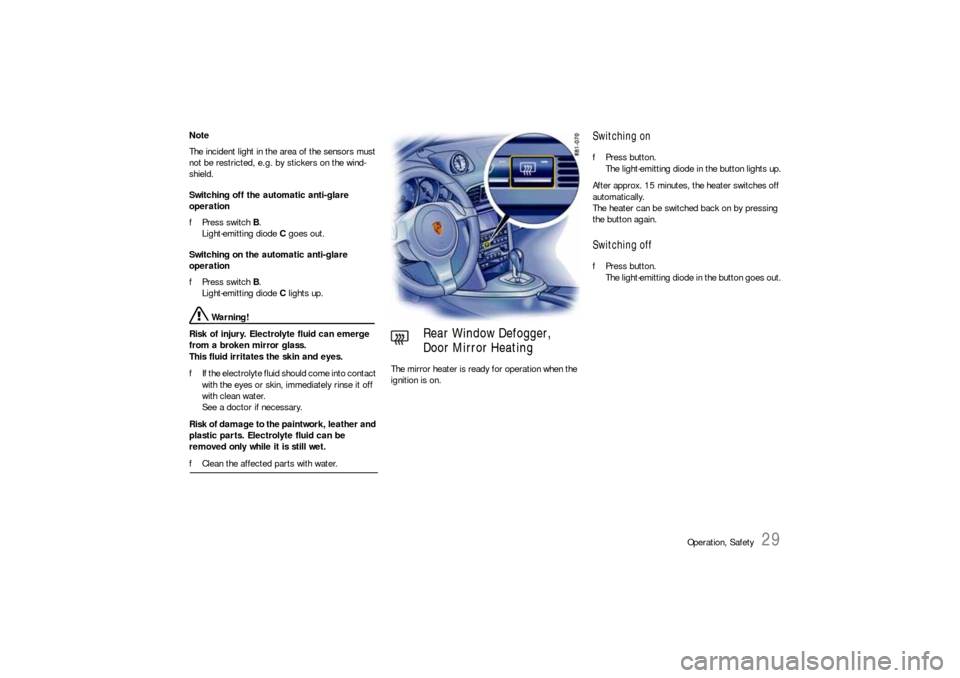
Operation, Safety
29
Note
The incident light in the area of the sensors must
not be restricted, e.g. by stickers on the wind-
shield.
Switching off the automatic anti-glare
operation
fPress switch B.
Light-emitting diode C goes out.
Switching on the automatic anti-glare
operation
fPress switch B.
Light-emitting diode C lights up.
Warning!
Risk of injury. Electrolyte fluid can emerge
from a broken mirror glass.
This fluid irritates the skin and eyes.
fIf the electrolyte fluid should come into contact
with the eyes or skin, immediately rinse it off
with clean water.
See a doctor if necessary.
Risk of damage to the paintwork, leather and
plastic parts. Electrolyte fluid can be
removed only while it is still wet.
fClean the affected parts with water. The mirror heater is ready for operation when the
ignition is on.
Switching on fPress button.
The light-emitting diode in the button lights up.
After approx. 15 minutes, the heater switches off
automatically.
The heater can be switched back on by pressing
the button again.Switching off fPress button.
The light-emitting diode in the button goes out.
Rear Window Defogger,
Door Mirror Heating
Page 43 of 310

Operation, Safety
41
Safety Belts
Warning!
Always make sure your and your passengers’
safety belts are properly fastened while the
vehicle is in motion.
Failure to follow safety belt warnings may re-
sult in serious personal injury or death.
fFor your and your passengers’ protection, use
safety belts at all times while the vehicle is in
motion.
fUse appropriate child restraint systems for all
small children.
Proper wearing of safety belts
fSafety belts must be positioned on the body as
to restrain the upper body and lap from sliding
forward. Improperly positioned safety belts
can cause serious personal injury or death in
case of an accident.
fThe shoulder belt should always rest on your
upper body. The shoulder belt should never be
worn behind your back or under your arm.
fFor maximum effectiveness, the lap belt
should be worn low across the hips.
fPregnant women should position the belt as
low as possible across the pelvis. Make sure it
is not pressing against the abdomen. fBelts should not be worn twisted.
fDo not wear belts over rigid or breakable ob-
jects in or on your clothing, such as eye glass-
es, pens, keys, etc. as these may cause injury.
fSeveral layers of heavy clothing may interfere
with proper positioning of belts.
fBelts must not rub against sharp objects or
damage may occur to the belt.
fTwo occupants should never share the same
belt at the same time.
Care and maintenance
fKeep belt buckles free of any obstruction that
may prevent a secure locking.
fBelts that have been subjected to excessive
stretch forces in an accident must be inspect-
ed or replaced to ensure their continued effec-
tiveness in restraining you.
The same applies to belt tensioner systems
which have been triggered.
In addition, the anchor points of the belts
should be checked.
fIf safety belts do not work properly, see your
authorized Porsche dealer immediately.
fIf the belts show damage to webbing, bindings,
buckles or retractors, they should be replaced
to ensure safe operation.
fDo not modify or disassemble the safety belts
in your vehicle. fThe belts must be kept clean or the retractors
may not work properly.
Please see the chapter “CAR CARE INSTRUC-
TIONS” on Page 224.
fNever bleach or dye safety belts.
fDo not allow safety belts to retract until they
are completely dry after cleaning or this may
cause damage to the belt.
Belt tensioner Depending on the force of an impact, fastened
front seat safety belts are tightened in an acci-
dent.
The belt tensioners are triggered in:
– Front, side and rear impacts of sufficient
severity.
– For the Cabriolet, in cases of vehicle rollover.
Note
The belt-tensioner system can be triggered only
once; the system must be replaced afterward.
If there is a fault in the belt-tensioner system, the
airbag warning light lights up.
Work may be performed on the belt-tensioner sys-
tem only by an authorized Porsche dealer.
Smoke is released when the belt tensioners are
triggered. This does not indicate a fire in the
vehicle.
Page 44 of 310
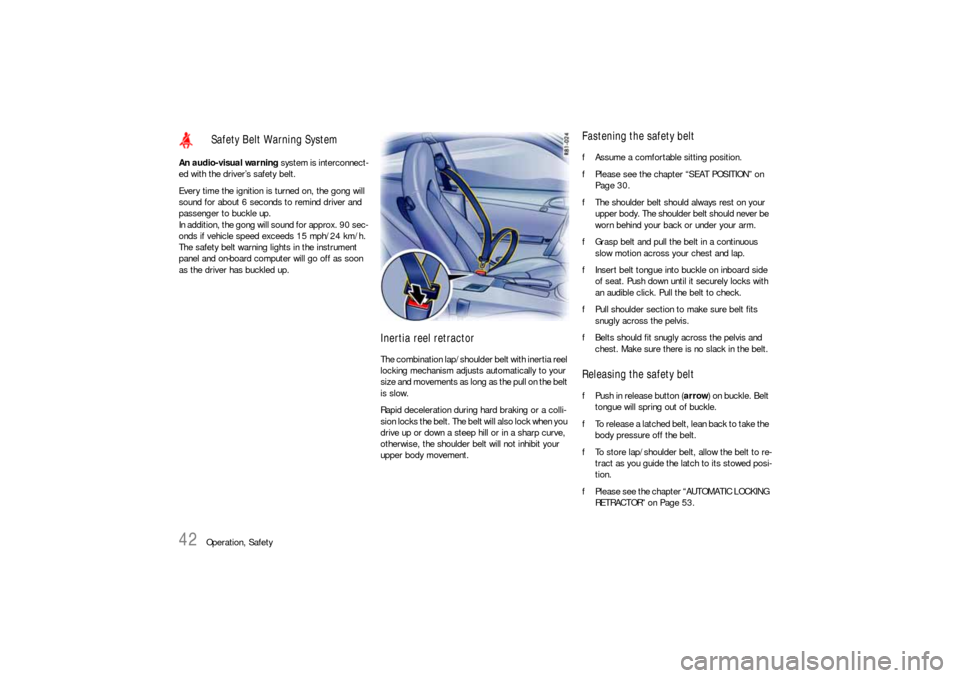
42
Operation, Safety An audio-visual warning system is interconnect-
ed with the driver’s safety belt.
Every time the ignition is turned on, the gong will
sound for about 6 seconds to remind driver and
passenger to buckle up.
In addition, the gong will sound for approx. 90 sec-
onds if vehicle speed exceeds 15 mph/24 km/h.
The safety belt warning lights in the instrument
panel and on-board computer will go off as soon
as the driver has buckled up.
Inertia reel retractor The combination lap/shoulder belt with inertia reel
locking mechanism adjusts automatically to your
size and movements as long as the pull on the belt
is slow.
Rapid deceleration during hard braking or a colli-
sion locks the belt. The belt will also lock when you
drive up or down a steep hill or in a sharp curve,
otherwise, the shoulder belt will not inhibit your
upper body movement.
Fastening the safety beltfAssume a comfortable sitting position.
fPlease see the chapter “SEAT POSITION” on
Page 30.
fThe shoulder belt should always rest on your
upper body. The shoulder belt should never be
worn behind your back or under your arm.
fGrasp belt and pull the belt in a continuous
slow motion across your chest and lap.
fInsert belt tongue into buckle on inboard side
of seat. Push down until it securely locks with
an audible click. Pull the belt to check.
fPull shoulder section to make sure belt fits
snugly across the pelvis.
fBelts should fit snugly across the pelvis and
chest. Make sure there is no slack in the belt. Releasing the safety beltfPush in release button (arrow) on buckle. Belt
tongue will spring out of buckle.
fTo release a latched belt, lean back to take the
body pressure off the belt.
fTo store lap/shoulder belt, allow the belt to re-
tract as you guide the latch to its stowed posi-
tion.
fPlease see the chapter “AUTOMATIC LOCKING
RETRACTOR” on Page 53.
Safety Belt Warning System
Page 49 of 310

Operation, Safety
47
PASSENGER AIRBAG OFF indicator lampNote on operation
Although not desired, it can occur in the case of
heavier children that the passenger’s airbag re-
mains active or, in the case of very light adults or
young persons, that the passenger’s airbag is
deactivated.
The condition of the passenger’s front airbag is
shown by the indicator lamp.
If in doubt:
fPlease see the chapter “PASSENGER AIRBAG
OFF INDICATOR LAMP DOES NOT LIGHT UP”
on Page 47.fPlease see the chapter “KEY-OPERATED AIR-
BAG DEACTIVATION DEVICE” on Page 49.
fPlease see the chapter “CHILD RESTRAINT
SYSTEMS” on Page 50.
fPlease see the chapter “LATCH SYSTEM
CHILD SEAT BRACKET ON THE PASSENGER’S
SEAT” on Page 54.
Note
fAfter inserting the ignition key, the PASSEN-
GER AIRBAG OFF warning light lights up for a
few seconds as a bulb check.
PASSENGER AIRBAG OFF indicator lamp
lights up
– The passenger's airbag is switched off.
PASSENGER AIRBAG OFF indicator lamp
does not light up
– The passenger's airbag is active and ready for
operation.
– If the passenger's seat is not occupied, the
PASSENGER AIRBAG OFF indicator lamp will
also not light up, even though the passenger's
airbag is switched off.
Danger!
Risk of serious personal injury or death due
to the passenger airbag triggering uninten-
tionally.
When the ignition key is inserted and the up
to one-year old child is seated in the child re-
straint system on the passenger’s seat, the
indicator lamp “PASSENGER AIRBAG OFF”
must be on.
If the “PASSENGER AIRBAG OFF” indicator
lamp does not light up, it could indicate a
fault in the system.
In this case:
fChild restraint systems facing forwards:
Install on the rear seats.
fChild restraint systems facing rearwards:
On vehicles with key-operated airbag deactiva-
tion device: Switch to position OFF.
fChild restraint systems facing rearwards:
On vehicles without key-operated airbag deac-
tivation device: Do not use a child restraint sys-
tem in the front passenger’s seat.
fHave the fault remedied at your nearest author-ized Porsche dealer.
Page 59 of 310
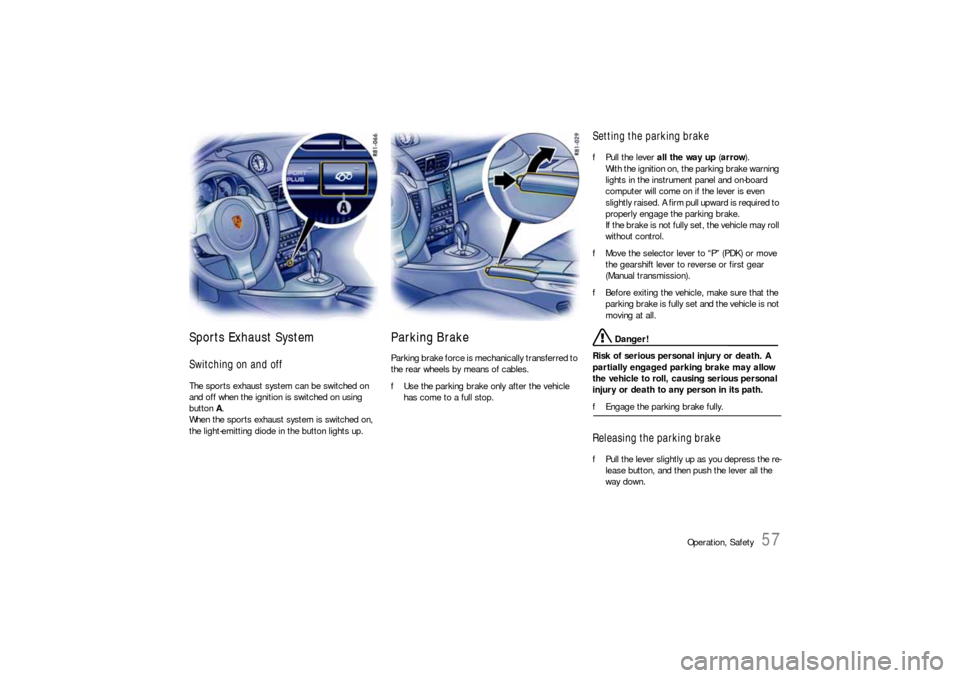
Operation, Safety
57
Sports Exhaust SystemSwitching on and offThe sports exhaust system can be switched on
and off when the ignition is switched on using
button A.
When the sports exhaust system is switched on,
the light-emitting diode in the button lights up.
Parking Brake Parking brake force is mechanically transferred to
the rear wheels by means of cables.
fUse the parking brake only after the vehicle
has come to a full stop.
Setting the parking brake fPull the lever all the way up (arrow).
With the ignition on, the parking brake warning
lights in the instrument panel and on-board
computer will come on if the lever is even
slightly raised. A firm pull upward is required to
properly engage the parking brake.
If the brake is not fully set, the vehicle may roll
without control.
fMove the selector lever to “P” (PDK) or move
the gearshift lever to reverse or first gear
(Manual transmission).
fBefore exiting the vehicle, make sure that the
parking brake is fully set and the vehicle is not
moving at all.
Danger!
Risk of serious personal injury or death. A
partially engaged parking brake may allow
the vehicle to roll, causing serious personal
injury or death to any person in its path.
fEngage the parking brake fully.Releasing the parking brakefPull the lever slightly up as you depress the re-
lease button, and then push the lever all the
way down.
Page 60 of 310

58
Operation, Safety The warning lights in the instrument panel and on-
board computer will go out after the parking brake
is fully released.
The warning lights are not an indicator that the
parking brake is fully set; it is only intended to be
a warning to release the parking brake before
driving the car. Caution!
A partially engaged brake will overheat the
rear brakes, reduce their effectiveness and
cause excessive wear.
fRelease the parking brake fully.
fWhen parking your car, always set the parking
brake by pulling all the way up on the lever.
fMove the selector lever to “P” (PDK) or move
the gearshift lever to reverse or first gear
(Manual transmission).
fOn hills also turn the front wheels towards the
curb.
Brakes fMake it a habit to check the operation of your
brakes before driving.
Keep in mind that the braking distance increases
very rapidly as the speed increases. At 60 mph or
100 km/h, for example, it is not twice but four
times longer than 30 mph or 50 km/h. Tire trac-
tion is also less effective when the roads are wet
or slippery.
fTherefore, always maintain a safe distance
from the car in front of you.
Vehicles without Porsche Ceramic Compos-
ite Brake (PCCB)
Even though the brake discs consist of alloyed
grey cast iron, they will unavoidably start to cor-
rode if your car is parked for an extended period.
The brakes will tend to “rub” as a result.
The nature, extent and effects of corrosion de-
pend on the amount of time the vehicle was
parked, whether granular or liquid road salt was
spread and whether grease-dissolving agents
were used in car washes.
To prevent corrosion of the brake discs, “brake
them dry” before parking the car.
If the braking comfort is noticeably impaired, we
recommend having the brake system checked by
experts at an authorized Porsche dealer.
Brake system function Your Porsche is equipped with a power assisted
hydraulic dual circuit brake system with disc
brakes at the front and rear.
Both circuits function independently. One brake
circuit operates the front and the other operates
the rear.
If one brake circuit has failed, the other will still op-
erate. However, you will notice an increased pedal
travel when you apply the brakes.
Failure of one brake circuit will cause the stopping
distance to increase.
Warning!
Risk of an accident, resulting in serious per-
sonal injury or death.
In the unlikely event of hydraulic failure of
one brake circuit:
fPush the brake pedal down firmly and hold it in
that position.
A mechanical linkage activates the second cir-
cuit, and you will be able to bring the vehicle to
a stop.
fAfter bringing your vehicle to a complete stop,
avoid driving the vehicle and instead have it
towed to the nearest authorized Porsche deal-er for repair.
Parking brake warning light USA
Parking brake warning light
Canada
Page 61 of 310

Operation, Safety
59
Brake system warning light
You can check the functionality of the brake
system warning light by switching the ignition to
the "On" position and verifying that the warning
light illuminates.
If the warning lights in the instrument panel and on-
board computer go on while driving, the brake flu-
id level may be too low, or (if the brake pedal travel
has increased) one of the two brake circuits may
have failed.
A greater braking pressure will be required, stop-
ping distances will be longer and the braking be-
havior will change, particularly in curves.
With correctly adjusted brakes, and a correctly
working brake system, the pedal travel to the
point of brake actuation should be 1-3/16 in. to
1-9/16 in. or 30 to 40 mm.
Whenever the brake pedal travel exceeds this dis-
tance, have the brake system checked.
Brake pedal
Warning!
Risk of an accident, resulting in serious per-
sonal injury or death.
Any obstruction of the brake pedal could
increase the stopping distance.
fAlways check the movement of the brake pedal
before driving and make sure that it is not ob-
structed by a floor mat or any other object.
fSecure the floor mat to prevent it from sliding
into positions that could interfere with the safe
operation of your vehicle.
Your Porsche dealer will be glad to offer you nonskid floor mats of the correct size.
Note
In case one of the two brake circuits fails, in-
creased pedal travel is required to bring your
vehicle to a full stop.
Warning!
To avoid overheating and premature wear of
the brakes:
fBefore descending a steep grade, reduce
speed and shift the transmission into a lower
gear or driving position to control speed.
fDo not “ride the brakes” by resting your foot on
the pedal when not intending to apply brake
pressure.
fDo not hold the pedal down too long or too
often.
This could cause the brakes to get hot and not function properly.
Brake warning light USA
Brake warning light Canada